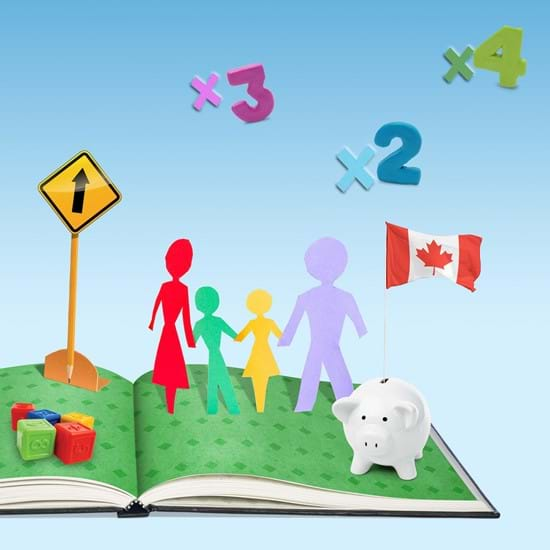
Can I Afford My First House?

Written by: François Gagnon
For most couples, buying their first house is probably one of their biggest dreams… and investment! Before you take the leap, there are some questions you should ask yourself and definitely some planning to do.
Can you afford it?
As soon as you start searching for the perfect house, there’s a lot to think about: mortgage rules, house prices, mortgage insurance… and let’s not forget that life goes on after you’ve bought your dream home, so you need to plan accordingly. If your first calculations suggest a financial strain in the years to come, you may need to revise your plans.
Before you visit a first house, and long before your first bank appointment, you need to go back to the basics and do your homework.
We’ve talked about it in the past: before you make a major financial decision, like investing thousands of dollars in a house, you should make a budget to get a snapshot of your current financial situation. Once you’ve fully assessed your income and your expenses, you’ll have a clear picture of the maximum mortgage you can get and the means you have to invest.
Mortgage rules
Before you start your calculations, you need to decide on the sum you are willing to put as a down payment on the house, since the applicable rules will vary according to this initial investment. If your down payment is less than 20% of the property’s buying price, you will need to get loan insurance. This doesn’t apply if your down payment exceeds the 20% threshold.
However, know that regardless of your decision, your down payment must correspond to at least 5% of the property’s value. For instance, if you are looking to buy a house worth $250,000, your down payment must total at least $12,500. Since that’s less than 20% of the house’s value, you’ll need to add 4% to your mortgage to cover insurance.
Here’s a breakdown of what your calculation should look like:
|
Property’s value |
$250,000 |
|
Down payment |
$12,500 |
|
Loan |
$237,000 |
|
Mortgage insurance (4%) |
$9,500 |
|
Total mortgage |
$247,000 |
After you’ve done the math and determined how much you can borrow, you have to pass the stress test. Your bank must confirm that you will be able to meet your financial obligations, even if the interest rate increases. Therefore, if you need mortgage insurance, your bank will determine if you qualify by making the necessary calculations using the higher of the following interest rates:
- the Bank of Canada’s conventional 5-year mortgage rate, and
- the interest rate you negotiated with your lender.
If you don’t need insurance, the bank will apply the higher of the interest rates below:
- the Bank of Canada’s conventional 5-year mortgage rate, and
- the interest rate you negotiated with your lender plus 2%.
You CAN negotiate your mortgage
One of the worst mistakes that first-time home buyers can make is to accept the first mortgage offer the get without shopping around to see if there’s a better deal out there with another lender. There IS always room for negotiation, no matter how small. I suggest you get offers from two or three financial institutions so you get a better idea of what’s available. And if you aren’t a natural born negotiator, you can always ask a mortgage broker’s help to get the lowest rate possible. In the end, even a 0.25% difference could save you thousands of dollars.
Moreover, don’t fall for your bank’s cashback mortgage: if they can afford to offer you a cashback option, it means they could probably offer you a lower rate instead. This is the perfect opportunity to negotiate some more!
My final tip to help you save even more money is that you shouldn’t accept the mortgage insurance your bank will most certainly offer you. Why? Because you can probably get a better deal with an insurance company specialized in mortgage insurance.
Using RRSP funds… wisely
It’s important to know that you can use RRSP funds to make a down payment. But please, don’t make the mistake of taking out a $20,000 loan to invest in an RRSP, and then using it as a down payment. The marginal tax rate for a $50,000 income is 27.5%, meaning you would save $6,000 on your investment, but you still have $14,000 to repay.
Variable or fixed rate?
The last question you should ask yourself is whether to choose a variable or fixed rate. The answer will vary according to your risk tolerance, the current economy and your financial capacity.
While a variable rate ends up being cheaper than a fixed rate, a variable rate mortgage will be impacted directly by any increase (or decrease) in the Bank of Canada’s rate. For instance, a 0.25% increase on a $300,000 mortgage would mean a $36 increase per month. If there were four increases during the year, you’d end up paying an extra $144 per month, for annual total of $1,728.
If increases in your interest rate make you nervous, I strongly suggest that you go for a fixed 5-year rate; it might be more expensive, but at least you’ll have peace of mind.
In the end, what you should remember when negotiating your mortgage is that if you think big, you’ll end up having to cut on other expenses and restricting yourself further. Take some time to assess your financial capacity and your risk tolerance, but also to consider every aspect of an offer before you accept it.
Here are some links to bring you closer to your dream home:
Calculate how much you can borrow: http://itools-ioutils.fcac-acfc.gc.ca/MQ-HQ/MQ-EAPH-eng.aspx
Mortgage repayment calculator: http://itools-ioutils.fcac-acfc.gc.ca/MQ-HQ/MQ-EAPH-eng.aspx


